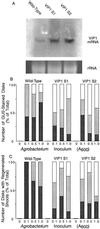Increasing plant susceptibility to Agrobacterium infection by overexpression of the Arabidopsis nuclear protein VIP1
- PMID: 12124400
- PMCID: PMC124932
- DOI: 10.1073/pnas.162304099
Increasing plant susceptibility to Agrobacterium infection by overexpression of the Arabidopsis nuclear protein VIP1
Abstract
Agrobacterium is a unique model system as well as a major biotechnological tool for genetic manipulation of plant cells. It is still unknown, however, whether host cellular factors exist that are limiting for infection, and whether their overexpression in plant cells can increase the efficiency of the infection. Here, we examined the effect of overexpression in tobacco plants of an Arabidopsis gene, VIP1, which encodes a recently discovered cellular protein required for Agrobacterium infection. Our results indicate that VIP1 is imported into the plant cell nucleus via the karyopherin alphadependent pathway and that elevated intracellular levels of VIP1 render the host plants significantly more susceptible to transient and stable genetic transformation by Agrobacterium, probably because of the increased nuclear import of the transferred-DNA.
Figures




Similar articles
-
Is VIP1 important for Agrobacterium-mediated transformation?Plant J. 2014 Sep;79(5):848-60. doi: 10.1111/tpj.12596. Epub 2014 Aug 5. Plant J. 2014. PMID: 24953893
-
VIP1, an Arabidopsis protein that interacts with Agrobacterium VirE2, is involved in VirE2 nuclear import and Agrobacterium infectivity.EMBO J. 2001 Jul 2;20(13):3596-607. doi: 10.1093/emboj/20.13.3596. EMBO J. 2001. PMID: 11432846 Free PMC article.
-
The VirE3 protein of Agrobacterium mimics a host cell function required for plant genetic transformation.EMBO J. 2005 Jan 26;24(2):428-37. doi: 10.1038/sj.emboj.7600524. Epub 2004 Dec 23. EMBO J. 2005. PMID: 15616576 Free PMC article.
-
VIP1: linking Agrobacterium-mediated transformation to plant immunity?Plant Cell Rep. 2010 Aug;29(8):805-12. doi: 10.1007/s00299-010-0870-4. Epub 2010 May 15. Plant Cell Rep. 2010. PMID: 20473505 Review.
-
Biological systems of the host cell involved in Agrobacterium infection.Cell Microbiol. 2007 Jan;9(1):9-20. doi: 10.1111/j.1462-5822.2006.00830.x. Cell Microbiol. 2007. PMID: 17222189 Review.
Cited by
-
Association of the Agrobacterium T-DNA-protein complex with plant nucleosomes.Proc Natl Acad Sci U S A. 2008 Oct 7;105(40):15429-34. doi: 10.1073/pnas.0805641105. Epub 2008 Oct 1. Proc Natl Acad Sci U S A. 2008. PMID: 18832163 Free PMC article.
-
Molecular analysis of Agrobacterium T-DNA integration in tomato reveals a role for left border sequence homology in most integration events.Mol Genet Genomics. 2007 Oct;278(4):411-20. doi: 10.1007/s00438-007-0259-4. Epub 2007 Jun 16. Mol Genet Genomics. 2007. PMID: 17574477
-
Agrobacterium-mediated transformation as a tool for functional genomics in fungi.Curr Genet. 2005 Jul;48(1):1-17. doi: 10.1007/s00294-005-0578-0. Epub 2005 May 12. Curr Genet. 2005. PMID: 15889258 Review.
-
Agrobacterium aiming for the host chromatin: Host and bacterial proteins involved in interactions between T-DNA and plant nucleosomes.Commun Integr Biol. 2009;2(1):42-5. doi: 10.4161/cib.2.1.7468. Commun Integr Biol. 2009. PMID: 19513263 Free PMC article.
-
TRA1: A Locus Responsible for Controlling Agrobacterium-Mediated Transformability in Barley.Front Plant Sci. 2020 Apr 16;11:355. doi: 10.3389/fpls.2020.00355. eCollection 2020. Front Plant Sci. 2020. PMID: 32373138 Free PMC article.
References
-
- Gelvin S. B. (2000) Annu. Rev. Plant Physiol. Plant Mol. Biol. 51, 223-256. - PubMed
-
- Tzfira T., Rhee, Y., Chen, M.-H. & Citovsky, V. (2000) Annu. Rev. Microbiol. 54, 187-219. - PubMed
-
- Tzfira T. & Citovsky, V. (2000) Mol. Plant Pathol. 1, 201-212. - PubMed
-
- Zupan J., Muth, T. R., Draper, O. & Zambryski, P. C. (2000) Plant J. 23, 11-28. - PubMed
Publication types
MeSH terms
Substances
LinkOut - more resources
Full Text Sources
Other Literature Sources
Molecular Biology Databases

